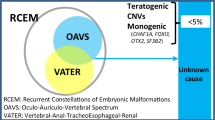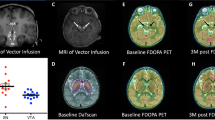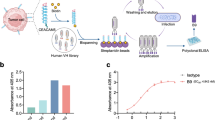Abstract
VATER association represents a cluster of Vertebral, Anal, Tracheo-Esophageal, Radial and Renal malformations, and caudal regression syndrome is an entity consisting of a spectrum of congenital anomalies of lower spine and hips associated with genitourinary and lower limb defects. The concurrence of various malformations may be explained by a common defect in blastogenesis, but direct evidence is yet to be accumulated. Here, by the use of autofluorescence and the teratogenic effect of adriamycin, we demonstrated that adriamycin administered to eggs of White Leghorns distributes to the caudal portion of the embryo and foregut epithelium and induces caudal regression and tracheal and pulmonary agenesis. The induction of caudal regression syndrome-like anomaly was developmental stage and dose dependent. Embryos with caudal regression demonstrated tracheoesophageal anomalies, one of the defects included in VATER association. The stages at which anomalies were produced corresponded to that of human embryos between days 22 and 26 (Carnegie stages 10–11). In view of the antitumor activity of adriamycin by intercalating to double-stranded DNA of undifferentiated cells undergoing rapid cell division, it is possible that adriamycin had preferentially attacked cells in the caudal end where pronounced proliferation takes place during this narrow period of greatest susceptibility.
Similar content being viewed by others
Log in or create a free account to read this content
Gain free access to this article, as well as selected content from this journal and more on nature.com
or
Abbreviations
- HH:
-
Hamburger-Hamilton
References
Quan L, Smith DW 1973 The VATER association. Vertebral defects, Anal atresia, T-E fistula with esophageal atresia, Radial and Renal dysplasia: a spectrum of associated defects. J Pediatr 82: 104–107
Kallen B 1987 Caudal aplasia. In: Myrianthopoulos NC (ed) Handbook of Clinical Neurology: Malformations. Elsevier Science, Amsterdam, pp 509–518
Duncan PA, Shapiro LR 1993 Interrelationships of the hemifacial microsomia-VATER, VATER, and sirenomelia phenotypes. Am J Med Genet 47: 75–84
Lubinsky M 1986 VATER and other associations: historical perspectives and modern interpretations. Am J Med Genet Suppl 2: 9–16
Jones K 2005 Smith's Recognizable Patterns of Human Malformation, 6th Ed. Elsevier Saunders, Philadelphia, pp 756–759
Schuler L, Salzano FM 1994 Patterns in multimalformed babies and the question of the relationship between sirenomelia and VACTERL. Am J Med Genet 49: 29–35
Temtamy SA, Miller JD 1974 Extending the scope of the VATER association: definition of the VATER syndrome. J Pediatr 85: 345–349
Botto LD, Khoury MJ, Mastroiacovo P, Castilla EE, Moore CA, Skjaerven R, Mutchinick OM, Borman B, Cocchi G, Czeizel AE, Goujard J, Irgens LM, Lancaster PA, Martinez-Frias ML, Merlob P, Ruusinen A, Stoll C, Sumiyoshi Y 1997 The spectrum of congenital anomalies of the VATER association: an international study. Am J Med Genet 71: 8–15
Kallen B, Winberg J 1974 Caudal mesoderm pattern of anomalies: from renal agenesis to sirenomelia. Teratology 9: 99–111
Russell LJ, Weaver DD, Bull MJ 1981 The axial mesodermal dysplasia spectrum. Pediatrics 67: 176–182
Opitz JM 1993 Blastogenesis and the primary field in human development. Birth Defects Orig Artic Ser 29: 3–37
Martinez-Frias ML, Frias JL, Opitz JM 1998 Errors of morphogenesis and developmental field theory. Am J Med Genet 76: 291–296
Muller F, O'Rahilly R 2004 The primitive streak, the caudal eminence and related structures in staged human embryos. Cells Tissues Organs 177: 2–20
O'Rahilly R, Muller F 1989 Interpretation of some median anomalies as illustrated by cyclopia and symmelia. Teratology 40: 409–421
Merei JM, Farmer P, Hasthorpe S, Qi BQ, Beasley SW, Myers NA, Hutson JM 1997 Timing and embryology of esophageal atresia and tracheo-esophageal fistula. Anat Rec 249: 240–248
Thompson DJ, Molello JA, Strebing RJ, Dyke IL 1978 Teratogenicity of adriamycin and daunomycin in the rat and rabbit. Teratology 17: 151–157
Marco A, Arcamone F 1975 DNA complexing antibiotics: daunomycin, adriamycin and their derivatives. Arzneimittelforschung 25: 368–374
Young RC, Ozols RF, Myers CE 1981 The anthracycline antineoplastic drugs. N Engl J Med 305: 139–153
Mortell A, Giles J, Bannigan J, Puri P 2003 Adriamycin effects on the chick embryo. Pediatr Surg Int 19: 359–364
Hamburger V, Hamilton HL 1951 A series of normal stages in the development of the chick embryo. J Morphol 88: 49–92
Primeau AJ, Rendon A, Hedley D, Lilge L, Tannock IF 2005 The distribution of the anticancer drug Doxorubicin in relation to blood vessels in solid tumors. Clin Cancer Res 11: 8782–8788
Maeda M, Sugiyama T, Akai F, Jikihara I, Hayashi Y, Takagi H 1998 Single stranded DNA as an immunocytochemical marker for apoptotic change of ischemia in the gerbil hippocampus. Neurosci Lett 240: 69–72
Watanabe I, Toyoda M, Okuda J, Tenjo T, Tanaka K, Yamamoto T, Kawasaki H, Sugiyama T, Kawarada Y, Tanigawa N 1999 Detection of apoptotic cells in human colorectal cancer by two different in situ methods: antibody against single-stranded DNA and terminal deoxynucleotidyl transferase-mediated dUTP-biotin nick end-labeling (TUNEL) methods. Jpn J Cancer Res 90: 188–193
Sundin O, Eichele G 1992 An early marker of axial pattern in the chick embryo and its respecification by retinoic acid. Development 114: 841–852
Kaplan S, Grabowski CT 1967 Analysis of trypan blue-induced rumplessness in chick embryos. J Exp Zool 165: 325–335
Diez-Pardo JA, Baoquan Q, Navarro C, Tovar JA 1996 A new rodent experimental model of esophageal atresia and tracheoesophageal fistula: preliminary report. J Pediatr Surg 31: 498–502
Merei J, Hasthorpe S, Farmer P, Hutson JM 1999 Visceral anomalies in prenatally adriamycin-exposed rat fetuses: a model for the VATER association. Pediatr Surg Int 15: 11–16
Muller F, O'Rahilly R 1983 The first appearance of the major divisions of the human brain at stage 9. Anat Embryol (Berl) 168: 419–432
Kiyomiya K, Matsuo S, Kurebe M 2001 Differences in intracellular sites of action of Adriamycin in neoplastic and normal differentiated cells. Cancer Chemother Pharmacol 47: 51–56
Hardonk MJ, Harms G 1990 The use of 5′-bromodeoxyuridine in the study of cell proliferation. Acta Histochem Suppl 39: 99–108
O'Rahilly R, Muller F 1987 Developmental stages in human embryos: including a revision of streeter's ‘Horizon' and a survey of the Carnegie Collection. Carnegie Institution of Washington, Washington, DC, pp 637
Mac Auley A, Werb Z, Mirkes PE 1993 Characterization of the unusually rapid cell cycles during rat gastrulation. Development 117: 873–883
Julian D, Abbott UK 1998 An avian model for comparative studies of insulin teratogenicity. Anat Histol Embryol 27: 313–321
Datar S, Bhonde RR 2005 Shell-less chick embryo culture as an alternative in vitro model to investigate glucose-induced malformations in mammalian embryos. Rev Diabet Stud 2: 221–227
Germann N, Goffinet F, Goldwasser F 2004 Anthracyclines during pregnancy: embryo-fetal outcome in 160 patients. Ann Oncol 15: 146–150
Acknowledgements
We thank Yuko Hashimoto for technical support.
Author information
Authors and Affiliations
Corresponding author
Additional information
Supported by the Japanese Ministry of Education, Culture, Sports, Science and Technology; in part by a Grant-in-Aid for Exploratory Research from the Japanese Ministry of Education, Culture, Sports, Science and Technology; and in part by a research grant from the Center of Excellence (COE) program “Basic Study and Clinical Application of the Human Stem Cell Biology and Immunology” (to Y.N.).
Rights and permissions
About this article
Cite this article
Naito, Y., Kimura, T., Aramaki, M. et al. Caudal Regression and Tracheoesophageal Malformation Induced by Adriamycin: A Novel Chick Model of VATER Association. Pediatr Res 65, 607–612 (2009). https://doi.org/10.1203/PDR.0b013e31819e7317
Received:
Accepted:
Issue date:
DOI: https://doi.org/10.1203/PDR.0b013e31819e7317
This article is cited by
-
Combination of Miller–Dieker syndrome and VACTERL association causes extremely severe clinical presentation
European Journal of Pediatrics (2014)
-
Mesenchymal expression of Tbx4 gene is not altered in Adriamycin mouse model
Pediatric Surgery International (2010)



